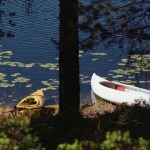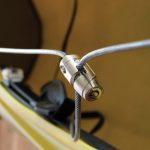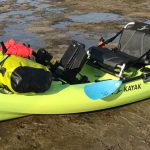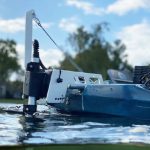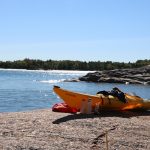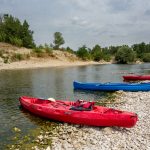Both kayaks and canoes have been used for thousands of years. But which watercraft is better, and why? Let's find out!
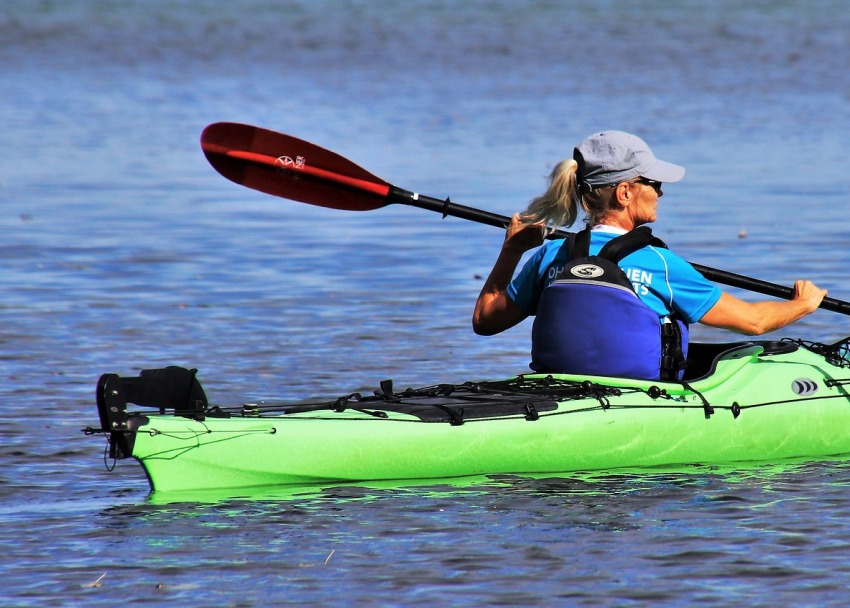
Every kayaker remembers just how much they struggled to paddle in a STRAIGHT line on their first trips out on the water.
And, if I’m being honest, there are still days when keeping my kayak on track in heavy winds and choppy water is not easy.
There are far too many times it seems like I want to go one way and my kayak insists on going another.
That’s the nature of watercraft for you—they can be trickier and a lot more stubborn than you might expect.
But that’s where kayak skegs and rudders come in handy!
Trust me, they’re game-changing additions. Since I installed a skeg on my kayak (a beast of a 14-foot Azul Riot), handling and tracking has significantly improved and I get where I’m going so much faster.
I want to share with you everything you need to know so you, too, can spend more time enjoying and less time struggling out on the water.
So come and join me for an in-depth look at kayak rudders and skegs, a paddler’s best friend!
As an affiliate of Amazon and other retailers, we may earn a small commission when you buy via our links, at no additional cost to you. Thank you!
Quick Answer: The Best Kayak Rudders and Skegs for You
Don’t have time to read the whole article? No worries! Take a look at these products I’ve found that will be ideal for your kayak customization:
- Borogo Kayak Rudder (designed for all kayaks, not specifically for one brand/model)
- Wilderness Systems Rudder Kit (specific to Wilderness Systems kayaks)
- Bullnose Clamp-on Boat Rudder
- FDSF Alloy Kayak Rudder
- DSHE Detachable Center Fin Black (I bought this one)
- SBS 10″ Surf & SUP Fin
- Borogo 8 inch Detachable Center Fin
Comparison Table: Best Kayak Rudders and Skegs
| Model | Specs | Where to Buy |
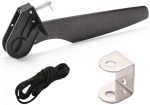 Borogo Kayak Rudder | Length: 18.5” Weight: Unspecified | Amazon |
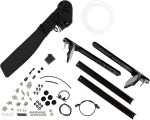 Wilderness Systems Rudder Kit | Length: 15.75” Weight: 2.82 lbs. | Amazon |
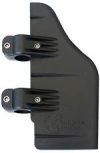 Bullnose Clamp-on Boat Rudder | Length: 10.5” Weight: 0.54 lbs. | Amazon |
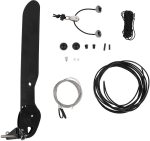 FDSF Alloy Kayak Rudder | Length: 20” (50.8 cm) Weight: Unspecified | Amazon |
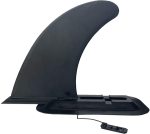 DSHE Detachable Center Fin Black | Length: 10.8” Weight: 0.83 lbs. | Amazon |
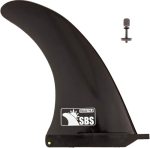 SBS 10″ Surf & SUP Fin | Length: 10” Weight: Unspecified | Amazon |
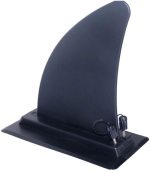 Borogo 8 inch Detachable Center Fin | Length: 8” Weight: Unspecified | Amazon |
Top-Rated Kayak Rudders and Skegs
Borogo Kayak Rudder

Length: 18.5” (47 cm)
Weight: Unspecified
This is a rudder mounting system designed for all kayaks, not specifically one brand or model. This means it’s incredibly versatile and can be used on pretty much any kayak, even if it doesn’t come rudder-ready. You can use it for your DIY rudder projects because it comes complete with all the requisite mounting hardware: rudder, mounting bracket, and a nylon control line that connects to your existing hand lever or foot pedal steering system.
The rudder doesn’t twist, but it can be raised and lowered to increase/decrease fluid resistance—similar to a fixed-blade skeg. It’s great for improving tracking without compromising your kayak’s handling.
For the price, you won’t find better anywhere!
Pros:
- Well-priced and affordable
- Compatible with all rudder-ready kayaks
- Great for DIY rudder installations
- Easy to mount
- Includes nylon control line
Cons:
- No instructions included, may be missing some hardware (bolts for mounting)
- Shipping time (from China) may be longer than expected
Wilderness Systems Rudder Kit
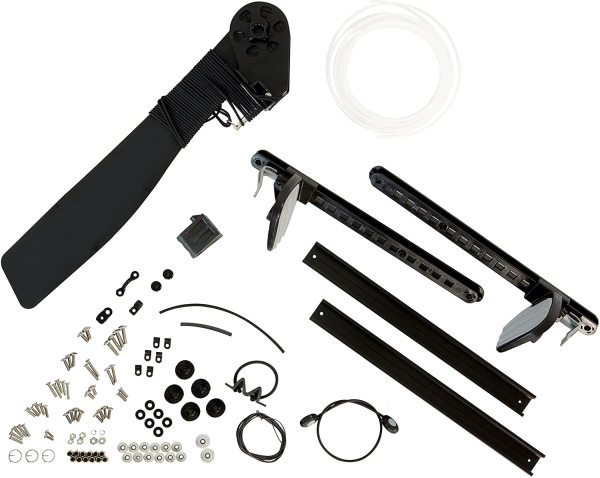
Length: 15.75” (40 cm)
Weight: 2.82 lbs. (1.28 kg)
This is by no means a small or light rudder system, but it will definitely get the job done. Fair warning: it’s only designed for Wilderness Systems kayaks (the site says the Tarpon 135T tandem), so it’s compatible with their specific hardware. However, you’ll find that with some slight modifications, you should be able to make it fit on most rudder-ready kayaks.
The kit is pricey, but includes all the hardware needed to install a rudder system: foot pedals, control and lift lines, the rudder mount, and all the various bolts, nuts, and washers.
Pros:
- Versatile and highly reliable rudder system
- Durable, solid hardware
- Includes everything for easy mounting
- Can be adapted to fit other kayaks (with some effort/additional parts)
Cons:
- Expensive compared to other rudders and skegs
- Designed specifically for Wilderness Systems kayaks
Bullnose Clamp-on Boat Rudder
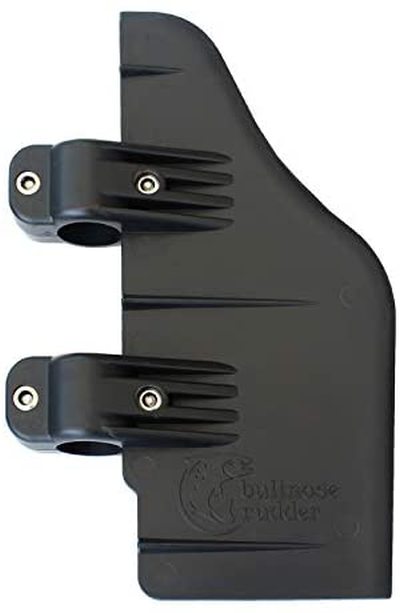
Length: 10.5” (26.7 cm)
Weight: 0.54 lbs. (0.24 kg)
If you want to add a rudder to your kayak trolling motor, this is exactly what you’re looking for! It’s designed to clamp onto the motor’s shaft (any shaft smaller than 1 1/8”) to improve handling with the trolling motor. If you’re an angler or hunter who uses their kayak with a motor, this is the rudder you’ll want to consider.
The rudder is made with a durable plastic that can withstand a lot of use. Though it’s seawater-rated, you’ll still need to do regular maintenance to keep it in good condition. You’ll find it’s beautifully easy to mount and may even last longer than the trolling motor itself.
Pros:
- Increases the tracking effectiveness of a trolling motor
- Built for durability and high performance
- Compatible with most trolling motor designs
- Gives you an edge against high winds and strong currents
Cons:
- Can only be installed on a trolling motor shaft
- Fixed-blade, doesn’t twist to improve steering
FDSF Alloy Kayak Rudder
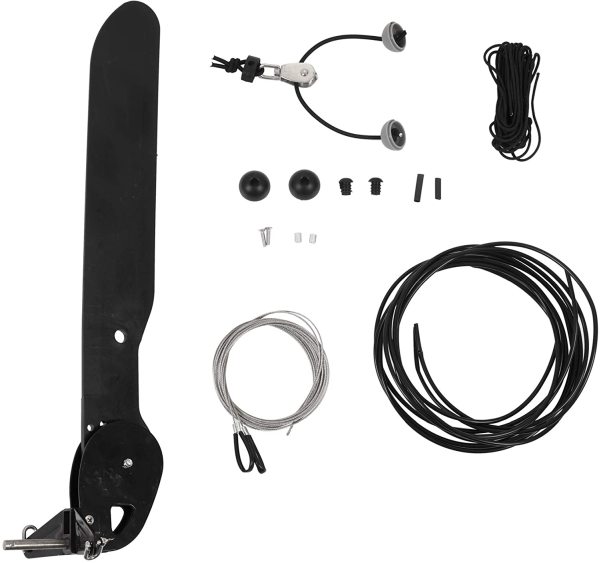
Length: 20” (50.8 cm)
Weight: Unspecified
This is another universally compatible rudder system that’s great for any rudder-ready kayak you want to upgrade. The price tag is reasonable, and the kit includes all the necessary hardware—including a unique-looking system that replaces the need for foot pedals (the instructions are a little unclear on exactly how it works, however).
There are only a few reviews on the product, so it’s not clear how reliable it is, but it appears to be a well-designed, easy-to-install rudder system that will work with most existing rudder mounts.
Pros:
- Affordable
- Includes all the required hardware, cables, and foot steering system
- Easy to secure in the raised position, locks against self-deploying
Cons:
- Limited information available online; no user reviews
DSHE Detachable Center Fin Black
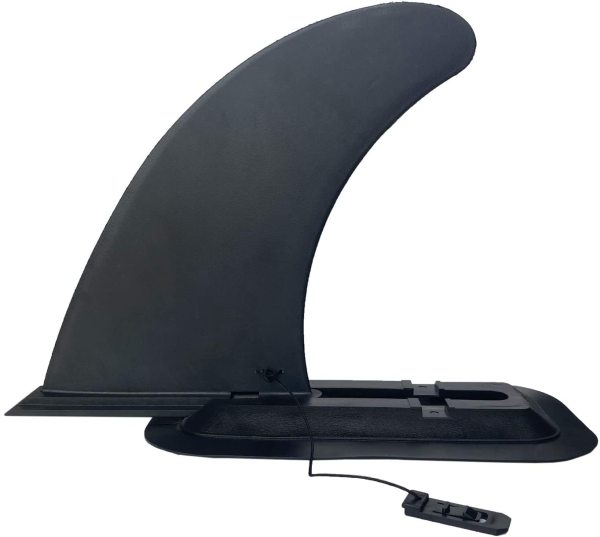
Length: 10.8” (27.4 cm)
Weight: 0.83 lbs. (0.37 kg)
This is the removable skeg that I bought to install on my Azul Riot kayak, and I’ve been using it for more than a year with absolutely no issues! The mount is super easy to install (using marine glue, as per the steps I listed above) and the fin slides into place with only minimal effort. However, once it’s fully inserted, the accompanying locking pin makes sure it’s absolutely secured.
The fiberglass-reinforced nylon composite material is very durable and abrasion-resistant, and it can handle impact or grating against rocky lake/riverbeds without breaking. Thanks to the 10-inch blade, my kayak tracks straighter than ever.
Pros:
- Easy to install
- Removable skeg great for both shallow and deep water
- Durable, well-built
- Excellent price tag
Cons:
- Does compromise handling slightly
SBS 10″ Surf & SUP Fin
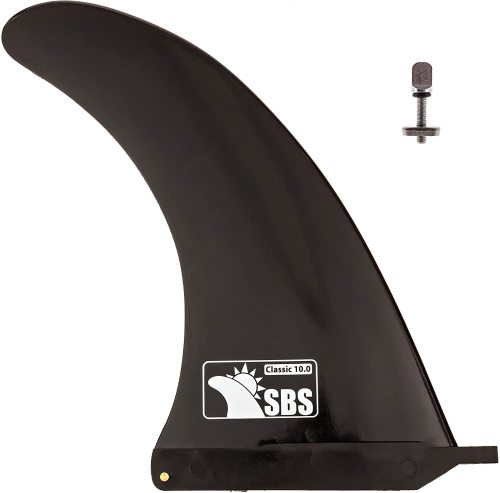
Length: 10” (25.4 cm)
Weight: Unspecified
This skeg is designed to be installed on surfboards, stand-up paddleboards, and kayaks that include an existing fin box (8.5-10.5”). It doesn’t include the mounting base to allow you to secure it to a kayak without a fin box, so you’ll need to purchase that hardware separately.
However, you’ll find that it’s easy to secure into your fin box without the need for tools, thanks to the special fin screw. The medium rake (curvature of the fin) makes it ideal for both flatwater and high-current environments.
Pros:
- Screws into place without the need for tools
- Affordable
- Compatible with most SUPs, surfboards, longboards, and kayaks with existing fin boxes
- Well-designed, reliable
Cons:
- Can’t be installed unless you have an existing fin box
Borogo 8 inch Detachable Center Fin
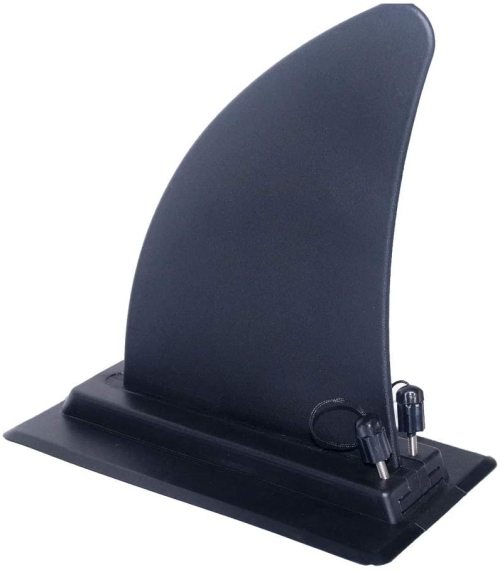
Length: 8” (20.3 cm)
Weight: Unspecified
This rubber skeg is an excellent addition to your kayak’s hull if you need help tracking straighter and don’t mind sacrificing a bit of handling. It’s designed to be secured to the hull using marine glue, and the skeg fin slides into the mount without the need for tools. Once it’s in, it locks securely into place and won’t come out for anything!
It’s slightly on the shorter side for a kayak skeg fin, but it’s great for flatwater and shallow lake/riverbeds. You’ll find it’s highly durable and capable of withstanding years of regular use in just about any water condition.
Pros:
- Cheap
- Easy to install using only marine glue
- Secured well, stays firmly in place
- Durable and reliable
Cons:
- Shorter than average
- No instructions included
Kayak Handling Explained: Tracking and Steering
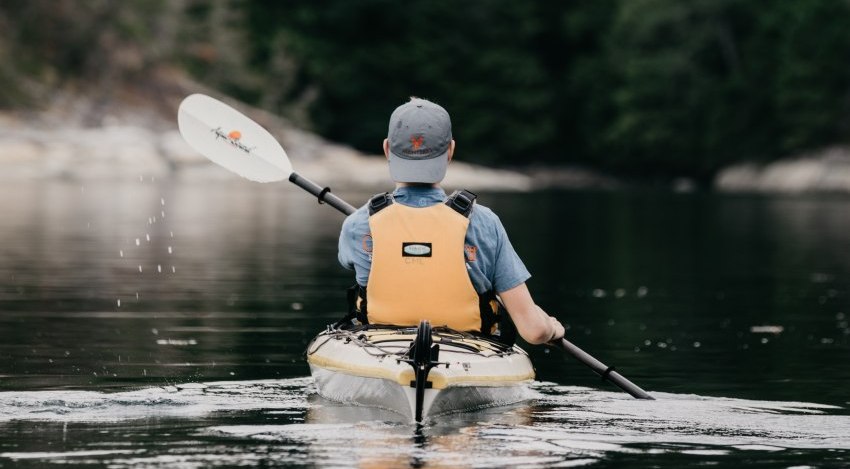
To understand why a kayak rudder or skeg is such a brilliantly useful addition to your kayak, you first need to understand the physics (only the basics!) of how kayaks typically handle.
Kayaks are designed to sit on top of the water, with only the hull partially submerged.
When you’re paddling forward and slicing through the water, the bow encounters minimal fluid resistance—also known as “drag”.
However, as the water slides along the hull of your kayak, the fluid resistance increases, and more lateral (side to side) pressure is exerted on the kayak. By the time the water reaches the stern (back of the kayak), there is high fluid resistance—ergo, more water pushing laterally against the kayak.
And that’s not all!
When the water slides past the bow, it envelops the bow and sort of “pins” it into place so it can track straight. However, when it slides off the stern, there is no “pinning”, so the back of the kayak tends to move around a lot more than the bow.
Add to this the current, waves, and winds hitting you from the side, and you’ve got a recipe for veering off track. The bow of your kayak stays straight, but the stern ends up moving around a lot more—what is known as “weathercocking”.
Compensating for Weathercocking
Most of the time, you end up compensating for weathercocking through your paddling stroke. If you notice your kayak is veering off to one side or the other, you typically adjust your stroke so you can turn back in the “right” direction and stay straight.
You can read all about the various paddling strokes in this article I wrote…
However, rudders and skegs are another VERY useful solution for counteracting weathercocking.
The blade of the rudder or skeg will slow down the movement of your stern, essentially stopping the waves, wind, and water current from pushing it off track. It will keep the stern of your kayak (mostly) aligned with the bow so you can slice straight through the water with minimal lateral movement.
Rudders can one-up the skeg’s fixed-blade design by twisting from side to side, allowing you to steer according to the wind, waves, and current. It’s an amazing addition that will drastically increase both tracking and handling.
Tracking vs. Handling: There is a Difference!
When I first started kayaking, I had no idea that these two were different terms. Thankfully, a buddy of mine explained them to me, and now I’m going to share them with you because understanding them will change the way you approach paddling.
Tracking refers to how straight the kayak moves. A kayak that “tracks” well will typically move in a very straight line, thanks to unique hull designs or the addition of a rudder or skeg.
Handling, also known as “steering”, refers to how maneuverable the kayak is, how efficiently it can make sharp turns. Think about it like the “turning radius” of your car—the better it handles, the more effectively it can turn.
Now, what you need to understand is that a kayak that tracks straight will typically be less maneuverable, while a kayak that steers very well and can make sharp turns often won’t track very straight.
This is because, in kayak design, these two elements (sort of) cancel each other out.
For example, a V-shaped hull will drastically improve tracking, but they’ll have less primary stability (on flat water) and be harder to handle. However, they’re designed specifically for currents and high waves—for example, out on the open ocean—and covering long distances.
Compare that to a rounded hull, which is designed for sharper turns and higher speeds. Because there is less depth to generate increased fluid resistance, the hull is more susceptible to weathercocking, but it allows you to make much sharper, crisper turns.
Which is more important? That’s a question only you can answer, really.
If your goal is to enjoy long, leisurely paddles on flatwater or travel long distances in a relatively straight line, it’s ideal to look for a kayak that tracks straight.
However, if you’re all about the adventure—whitewater kayaking, for example—and need a speedy kayak that can make sharp, quick turns, then you’ll want to consider handling/steering as the primary buying factor.
Rudders and Skegs Improve BOTH Factors
The beauty of kayak rudders and skegs is that they can improve both handling and tracking.
Fixed-blade skegs will increase tracking, helping to keep you moving in a straight line, and will slightly decrease handling.
Rudders, on the other hand, will give you better handling (thanks to their turnable design) while also improving tracking.
It’s all about finding the best system for your specific kayak—and that’s what we’re going to dive into in the next section.
Defining Kayak Rudders vs. Kayak Skegs
I want to take a moment to look more closely at the parts of these two systems. I hope it helps you understand the small but important differences between them.
Parts of a Kayak Rudder System
A rudder system typically comes with five parts:
- The blade. This is a long, narrow fin-like blade that extends from the stern of your kayak into the water.
- The pedals. These are the “steering controls” that allow you to use your feet to twist the blade from side to side. (Note: Some rudder systems use hand-levels, but pedals are the most common steering control.)
- The cables. These are cables, typically made from stainless steel, that connect the pedals to the blade.
- The mount. This is the hardware that secures the rudder to the stern of your kayak.
- The lift lines. These are long loops (typically located near your kayak’s cockpit) that let you stow or deploy your rudder.
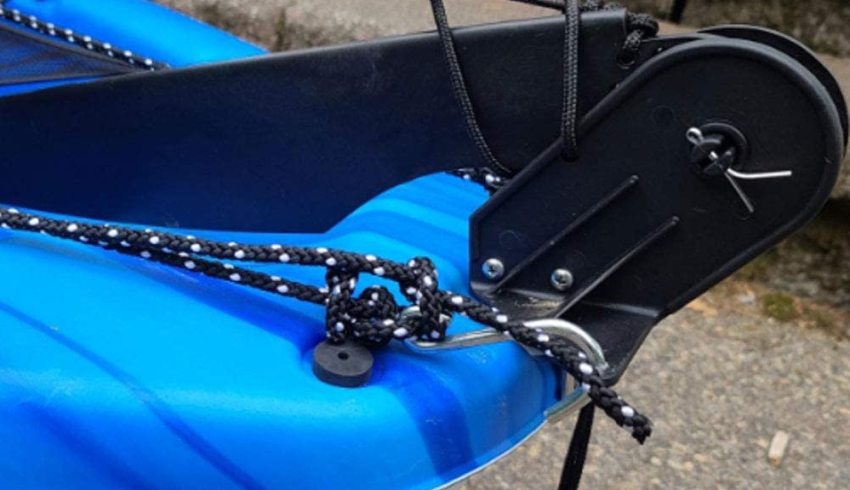
Connecting the rudder system can be a bit tricky. You’ve got to make sure your kayak is designed for or compatible with a rudder system (see more details below). But once it’s installed, steering is beautifully easy.
Press on the right-foot pedal to twist the rudder one way, and the left-foot pedal to twist it the other way.
Just like that, you’re steering your kayak where you want it to go because the blade extended into the water is directing the water that slides off the back of your stern in the “right” direction.
What is a Kayak Skeg?
A kayak skeg is basically a “fin” that is fixed to the underside of your kayak in the center of your hull, typically near the stern.
It functions the same as a rudder—cutting through the water that slides off the hull of your boat. But unlike a rudder, it doesn’t turn. This means that it’s less focused on maneuverability and its primary purpose is to improve tracking.
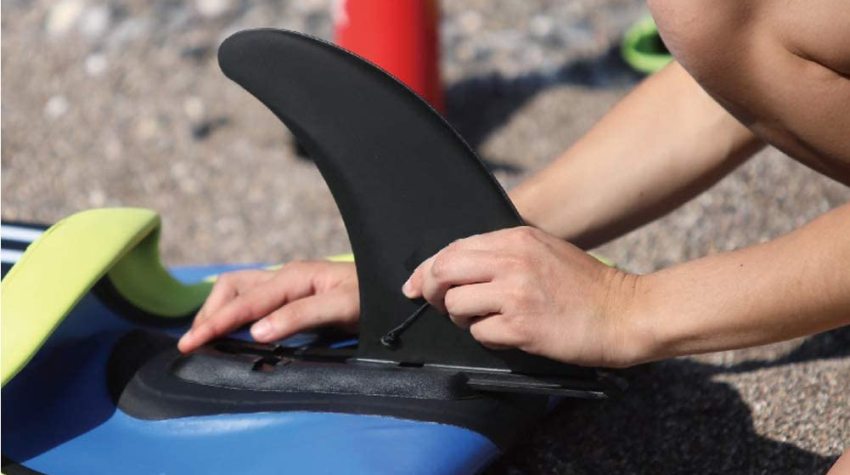
Some skegs are adjustable, allowing you to deploy part or all of the fin according to the water current. However, these tend to come built into the kayak. Any skeg you’re going to install yourself is likely to be a fixed, non-adjustable skeg. They’ll be less versatile, but still provide excellent tracking.
I will warn you that skegs can interfere with your handling. They’re designed to keep you tracking straight, and may slow down your ability to turn.
That’s why they’re typically used on kayaks that already handle really well, but struggle with tracking. Adding a skeg will ensure your responsive kayak travels in a straight line, and the addition won’t significantly impact your ability to steer and cut sharp turns.
Do I Need a Rudder or Skeg?
Now we come down to the really important question: do you actually NEED one of these steering/tracking systems on your kayak?
The short answer is “yes and no”.
Let me explain…
If your kayak tracks well but handles poorly, a rudder may be a useful addition to improve steering.
On the other hand, if your kayak handles great but struggles to track straight, both skegs and rudders may be a useful addition because they’ll keep your kayak traveling in a much straighter line.
However, there is no NEED for a kayak rudder or skeg. You can enjoy your casual, relaxing paddle with the kayak exactly as it is. Rudders and skegs just “level up” your ability to stay on course or make sharper turns, depending on what you’re looking for.
Kayak Rudder Pros
- Excellent handling corrective component
- Can compensate for high winds and strong currents
- Easy for beginners to learn to use
- Maximizes steering and tracking under any conditions
Kayak Rudder Cons
- Pricey
- Difficult to install if kayak isn’t compatible
- May create excessive drag if deployed incorrectly
- With a rudder, beginners don’t need to develop good paddling/handling skills
Kayak Skeg Pros
- Cheap and easy to install
- No moving parts to break
- No foot pedals to interfere with bracing (pushing with your feet) when paddling
- Less drag than a rudder
Kayak Skeg Cons
- Only designed to improve tracking; may negatively impact handling
- Steeper learning curve to master (specifically for adjustable skegs)
How to Mount Your Kayak Rudder
Mounting a kayak rudder can be very easy if the kayak is rudder-ready (designed to accommodate rudder hardware), but DIYing a rudder system can be very difficult if the kayak isn’t designed for a rudder.
For rudder-ready kayaks, the installation process can be as simple as:
Step 1: Install the mounting bracket to the pre-drilled holes.
Step 2: Insert the rudder into the mounting bracket.
Step 3: Connect the lift lines to the rudder mount and insert them into the pre-drilled holes.
Step 4: Set up the foot pedals in the kayak’s cockpit.
Step 5: Connect the rudder cables to the pedals and the rudder mount.
Just like that, you’re ready to get paddling!
However, if your kayak isn’t rudder-ready, you may have a harder time of it. Thankfully, the great people at Uberfy have an amazing video on how to DIY your kayak rudder, which will work for a wide variety of kayak types.
How to Mount Your Kayak Skeg
Mounting a kayak skeg can be a surprisingly easy task. My Azul Riot didn’t come with a built-in skeg, so I had to DIY it myself—a task that took all of 10 minutes!
To mount your own kayak skeg:
Step 1: Turn the kayak hull-side up and make sure it’s fully dry. It should be out of the water for AT LEAST 24-48 hours.
Step 2: Sand the hull where you want to apply the skeg. This roughs up the surface and creates a better bond with the adhesive.
Step 3: Glue the skeg mount to the hull. I used 3M Marine Adhesive Sealant Fast Cure 5200, and it worked like a charm!
Step 4: Let the glue cure. Typically, you’ll need to hold the skeg mount in place for 1-3 minutes for the glue to cure. Once it’s cured, you can release the pressure and let it sit to dry.
Step 5: Let the glue fully dry. Every glue has its specific drying time, but I recommend leaving it for at least 48 hours to make sure it’s solidly adhered.
And that’s it! Just like that, you’ve got a skeg ready
Note: This is a fixed-blade skeg, not a drop-down skeg. That is a much more complex job that may require cutting into your kayak’s hull. I recommend watching this video by Liquidlogic Kayaks if you’re thinking of DIYing a drop-down skeg:
Factors to Consider When Rudder or Skeg Shopping
I know you’re excited and ready to hit the water with your brand new steering/tracking system, but before you rush out to buy a new rudder or skeg, here are a few factors you need to consider:
● Hull Shape – Not all kayak hulls are compatible with skegs, in particular. For example, a V-shaped hull will have a sharp center line that will prevent you from being able to glue on a skeg. Skegs are typically most compatible with round, flat, or pontoon-bottom kayak hulls.
● Rudder-Ready Design – Remember, not all kayaks are rudder-ready. Some don’t come with the pre-drilled holes for the rudder mount or the cables, and aren’t designed to accommodate foot pedals. If your kayak isn’t rudder-ready, you’ll have to drill into the hull to install the rudder system.
● Provided vs. New Hardware – Some rudders include only the rudder and the hardware to install it to an existing mount. For these, you’ll need the lift lines, cables, foot pedals, and mount already installed—or you’ll have to buy them separately.
● Kayak Tracking vs. Handling – If your kayak already tracks well, you may want to opt for a rudder that improves handling. On the other hand, if you have a responsive kayak that needs help tracking, a skeg may be your better choice.
● Paddling Conditions – If you’re going to be exclusively paddling on flatwater lakes and calm rivers, your needs will be different than if you were going to tackle whitewater rapids, fast-flowing rivers, or tough ocean currents. Consider the system that best accommodates your paddling conditions.
● Length – Skeg length is a particularly important factor to consider when paddling in shallow waters (lakes or rivers). A long skeg may grind against the lake/river bed, which may make it more prone to scratching, bending, or even snapping. A skeg that’s too short, however, may not improve tracking significantly. Ideally, a kayak skeg should be between 6 and 10 inches.
● Fixed or Removable – A fixed skeg can never be removed, which can limit your paddling options in very shallow waters, and interfere with easy storage of your kayak. A removable skeg, however, may be more prone to damage, or may get lost/misplaced when stored.
FAQs
Yes, though it’s not an easy task! You may have to cut/drill into the rubber cone on the stern tip of the kayak, and you’ll have to run the cables around the frame and install your own foot pedal/hand level control system. The awesome people at Boats to Go have a great step by step guide to DIY installing a rudder to an inflatable kayak.
Headwinds (coming straight at you from the front) are typically hard to paddle in because the wind is pushing against you, so you have to work extra hard to make forward progress.
Tailwinds (coming from your back) will propel you forward and speed up your paddling.
Crosswinds (coming from the sides) are the trickiest, though, as they’ll push your boat off-course. Turn your kayak to paddle into the wind, and use your rudder/skeg to improve tracking.
There is no “one size fits all” answer to this question, because some more experienced paddlers can tackle heavy winds and strong currents while newbies may rather stay safe on the shore. However, any winds higher than 12 MPH (10 knots) are probably too strong to paddle safely. Out on the open ocean, wind speeds of 7-10 MPH (6-8.6 knots) can whip up the surf and make for a very choppy paddle.

